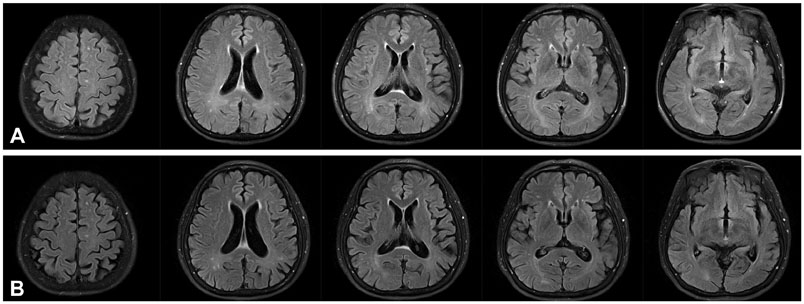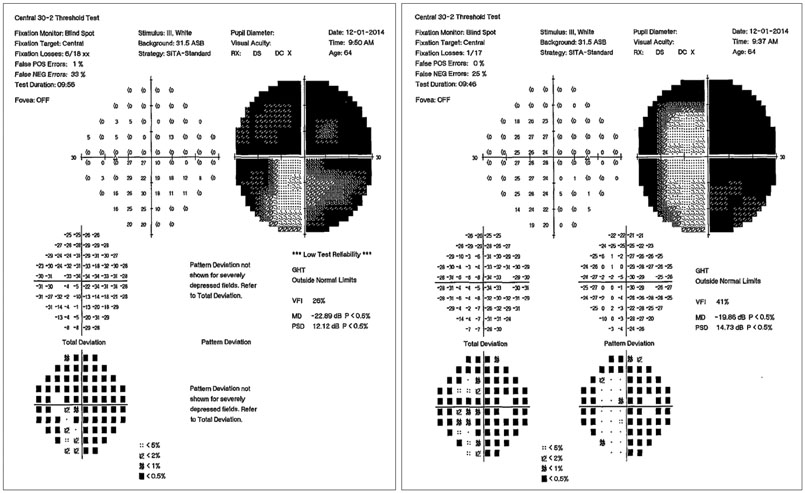Dement Neurocogn Disord.
2017 Dec;16(4):128-131. 10.12779/dnd.2017.16.4.128.
Posterior Type of Alzheimer's Dementia Presenting with Homonymous Hemianopsia
- Affiliations
-
- 1Department of Neurology, Korea University Medical Center, Seoul, Korea. kunu5347@gmail.com
- KMID: 2442730
- DOI: http://doi.org/10.12779/dnd.2017.16.4.128
Abstract
- BACKGROUND
Alzheimer's disease is a chronic neurodegenerative condition, mostly affecting the medial temporal lobe and associated neocortical structures. In this report, we present a rare clinical manifestation of this disease.
CASE REPORT
A 61-year-old female with word finding difficulty and memory disturbances was diagnosed with Alzheimer's disease. Two years later, she complained of right homonymous hemianopia without optic ataxia, ocular apraxia, and simultagnosia. No findings other than parenchymal disease were apparent in magnetic resonance imaging and laboratory tests.
CONCLUSIONS
In this case, in a patient initially diagnosed with Alzheimer's dementia with progressive disease, we found only homonymous hemianopia, without signs of Balint's syndrome or Gerstmann's syndrome. After careful investigation showing that Alzheimer's dementia with visual symptom was not associated with parenchymal disease, we concluded a case of atypical variant of Alzheimer's disease.
MeSH Terms
Figure
Reference
-
1. De-Paula VJ, Radanovic M, Diniz BS, Forlenza OV. Alzheimer's disease. Subcell Biochem. 2012; 65:329–352.
Article2. Apostolova LG. Alzheimer disease. Continuum (Minneap Minn). 2016; 22(2 Dementia):419–434.
Article3. Pellegrini F, Lee AG, Zucchetta P. Homonymous hemianopsia due to posterior cortical atrophy. Neuroophthalmology. 2017; 41:154–158.
Article4. Ishiwata A, Kimura K. Homonymous hemianopsia associated with probable Alzheimer's disease. J Nippon Med Sch. 2016; 83:87–92.
Article5. Benson DF, Davis RJ, Snyder BD. Posterior cortical atrophy. Arch Neurol. 1988; 45:789–793.
Article6. Crutch SJ, Lehmann M, Schott JM, Rabinovici GD, Rossor MN, Fox NC. Posterior cortical atrophy. Lancet Neurol. 2012; 11:170–178.
Article7. Renner JA, Burns JM, Hou CE, McKeel DW Jr, Storandt M, Morris JC. Progressive posterior cortical dysfunction: a clinicopathologic series. Neurology. 2004; 63:1175–1180.
Article8. Tang-Wai DF, Graff-Radford NR, Boeve BF, Dickson DW, Parisi JE, Crook R, et al. Clinical, genetic, and neuropathologic characteristics of posterior cortical atrophy. Neurology. 2004; 63:1168–1174.
Article9. Snowden JS, Stopford CL, Julien CL, Thompson JC, Davidson Y, Gibbons L, et al. Cognitive phenotypes in Alzheimer's disease and genetic risk. Cortex. 2007; 43:835–845.
Article10. Mendez MF, Ghajarania M, Perryman KM. Posterior cortical atrophy: clinical characteristics and differences compared to Alzheimer's disease. Dement Geriatr Cogn Disord. 2002; 14:33–40.
Article11. Shea YF, Chu LW. Visual field defect as an uncommon presentation of posterior cortical atrophy. Geriatr Gerontol Int. 2014; 14:1003–1004.
Article12. Cordano C, Alessandria G, Leonardi A, Cellerino M, Nourbakhsh B, Nobili F, et al. Homonymous hemianopia as the first sign of posterior cortical atrophy. J Neurol Sci. 2017; 373:38–40.
Article13. Wan SL, Bukowska DM, Ford S, Chen FK. Posterior cortical atrophy presenting with superior arcuate field defect. Case Rep Ophthalmol Med. 2015; 2015:796381.
Article14. Goodwin D. Homonymous hemianopia: challenges and solutions. Clin Ophthalmol. 2014; 8:1919–1927.
Article15. Auerbach SH, Alexander MP. Pure agraphia and unilateral optic ataxia associated with a left superior parietal lobule lesion. J Neurol Neurosurg Psychiatry. 1981; 44:430–432.
Article16. Perenin MT, Vighetto A. Optic ataxia: a specific disruption in visuomotor mechanisms. I. Different aspects of the deficit in reaching for objects. Brain. 1988; 111(Pt 3):643–674.
Article17. Lee AG, Martin CO. Neuro-ophthalmic findings in the visual variant of Alzheimer's disease. Ophthalmology. 2004; 111:376–380.
Article18. Vighetto A. Towards an earlier diagnosis of Alzheimer's disease presenting with visuospatial disorders (posterior cortical atrophy). Rev Neurol (Paris). 2013; 169:687–694.
Article
- Full Text Links
- Actions
-
Cited
- CITED
-
- Close
- Share
- Similar articles
-
- Isolated ipsilateral abducens nerve palsy and contralateral homonymous hemianopsia associated with unruptured posterior cerebral artery aneurysm: A rare neurological finding
- Visual Field Relocation and Clinical Effect of Fresnel Prism in Patients with Homonymous Hemianopsia
- A Case of Moyamoya Disease with Right Homonymous Hemianopsia
- Effect of Diabetes on Dementia and Its Preventive Strategies
- Biomarkers for Alzheimer's Dementia : Focus on Neuroimaging



